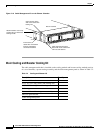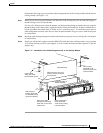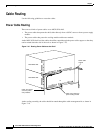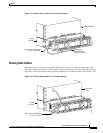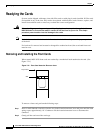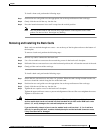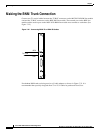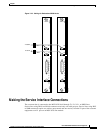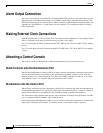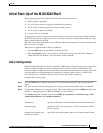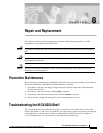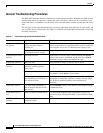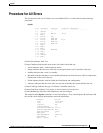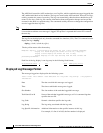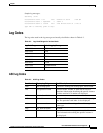
7-30
Cisco MGX 8220 Installation and Configuration
Release 5.0, Part Number 78-6430-03 Rev. D0, November 2003
Chapter
Alarm Output Connection
Alarm Output Connection
Dry contact relay closures are available for forwarding MGX 8220 alarms to a user office alarm system.
Separate visual and audible alarm outputs are available for both major and minor alarm outputs. The
MGX 8220 alarm outputs are available from a DB15 connector on the BNM line module faceplate. See
Appendix B, “Specifications,” for the pinouts on this connector. Use switchboard cable for running
these connections.
Making External Clock Connections
If the MGX 8220 node is to be synchronized to some other external equipment or a local digital central
office, a connector on the back card can be used to provide a clock input.
For a T1 clock input, the DB15 connector marked EXT TMG on the T3E3-D or SMF-155 line module
is used.
For a E1 clock input, the BNC connector marked EXT TMG on the T3E3-B or SMF-155 line module
is used.
Attaching a Control Console
The control console can be attached to either the maintenance port or to the control port.
Dumb Terminal onto the Maintenance Port
When using an alphanumeric (dumb) terminal to input command-line interface commands, the terminal
must be connected directly (no modem) to the maintenance port DB25 connector on the ASC line
module faceplate. Use a conventional RS-232 cable with a DB25 connector at each end. A so-called
“Null Modem” cable is not required. This port should never be Y-cabled.
Workstation onto the Control Port
When using a workstation to issue commands or transfer files to and from the shelf, the workstation can
be attached through the RS-232 control port on the ASC line module faceplate. Using this connection
requires the workstation to communicate using TCP/IP and SLIP communication protocols.
The workstation can be attached either directly with no modems or remotely through modems. In either
case, a conventional RS-232 modem cable should be used.
If the shelf has dual redundant ASC modules, use a Y-cable to connect the workstation or modem to the
control port of both the ASC modules. If a modem is used, a null-modem cable is required.



